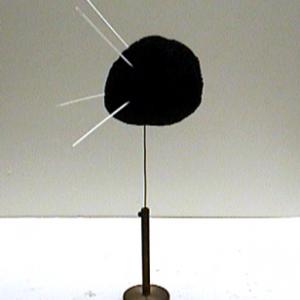College of Liberal Arts & Sciences
8A80.10 - Make a Comet
Note: The charcoal briquets are very hard and need to be prepped before putting them in the blender. Put 100 to 200 ml of water into the bottom of a plastic bowl and cover this with a layer of charcoal. The charcoal will absorb the water in about 24 hours and soften them enough so that they do not damage the blender when grinding.
Pick a recipe and try it out. I like that NASA JPL Recipe. Watch the NASA JPL "Create a Comet with Dry Ice" video below for a tutorial.
These are some good solutions:
1. NASA JPL Recipe:
- 5 lbs of Dry Ice
- 1 L of Water
- Around 2 Cups of Dirt
- 1 Tbsp or Less of Starch
- 1 Tbsp or Less of Dark Corn Syrup or Soda
- 1 Tbsp or Less of Vinegar
- 1 Tbsp or Less of Rubbing Alcohol
2. Dennis Schatz:
- 2 Cups of Water
- 2 Cups of Dry Ice
- 2 Spoonfuls of Sand or Dirt
- A Dash of Ammonia
- A Dash of Organic Material (Dark Corn Syrup Works Well)
3. Institue of Physics and Nuffield Foundation:
- 10 kg dry ice pellets
- 1 kg Garden Sand
- 2 litres water
- 1 handful soil (organic constituent)
- Worcestershire sauce (organic constituent)
- Smelling salts (organic constituent)
- Janice VanCleave, "33. Dirty Snowball", Janice VanCleave's 203 Icy, Freezing, Frosty, Cool, and Wild Experiments", p. 20.
- "Create a Comet with Dry Ice", NASA Jet Propulsion Laboratory.
- Dennis Schatz, "Making a Comet in the Classroom", Pacific Science Center/NATO Outreach, 1985.
- Institute of Physics and Nuffield Foundation, "How to Make a Comet",
- "Comet or Asteroid", Tap-L Conversations, by Brian Anderson, David Maiullo, Matt Lowry, David Sturm, Daniel R. Thompson, and Gerald Zani.
Disclaimer: These demonstrations are provided only for illustrative use by persons affiliated with The University of Iowa and only under the direction of a trained instructor or physicist. The University of Iowa is not responsible for demonstrations performed by those using their own equipment or who choose to use this reference material for their own purpose. The demonstrations included here are within the public domain and can be found in materials contained in libraries, bookstores, and through electronic sources. Performing all or any portion of any of these demonstrations, with or without revisions not depicted here entails inherent risks. These risks include, without limitation, bodily injury (and possibly death), including risks to health that may be temporary or permanent and that may exacerbate a pre-existing medical condition; and property loss or damage. Anyone performing any part of these demonstrations, even with revisions, knowingly and voluntarily assumes all risks associated with them.
